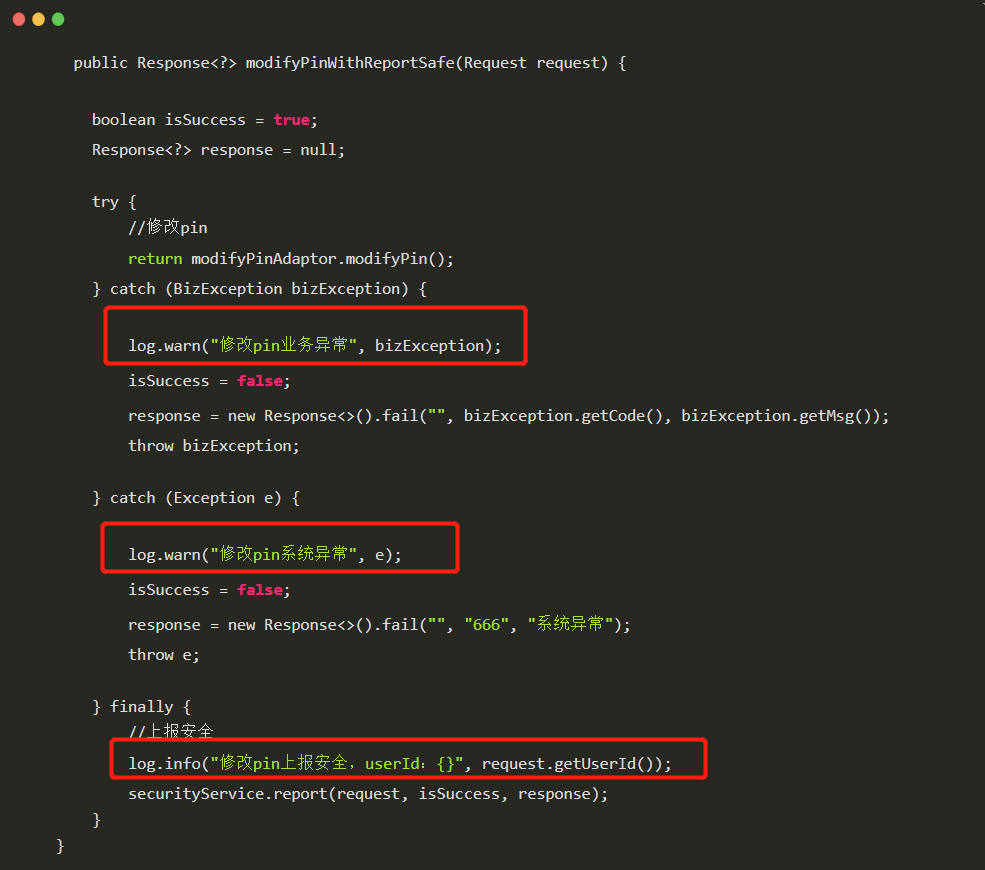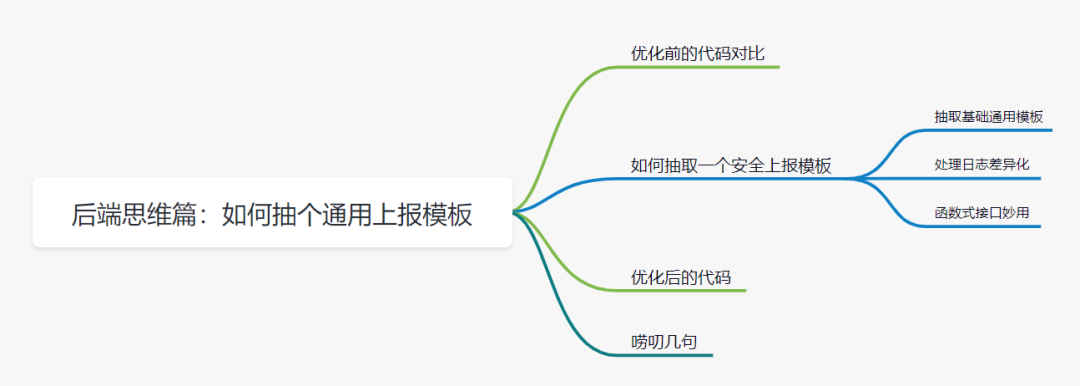后端思维篇:如何抽个通用上报模板
前言
我的后端思维专栏好久没更新啦,本文是后端思维专栏的第六篇哈。我的整个后端思维专栏都是跟日常工作相关的哈。
最近刚好优化了安全上报这块的代码,抽了一个基础模板,看起来挺优雅的。所以今天手把手教大家,基于重复代码,如何思考和抽取模板。
1 . 优化前的代码
我们的业务场景,如修改密码,修改pin等,需要将操作结果上报到安全管理中心系统。优化前的伪代码如下:
修改密码的逻辑:
public Response<?> modifyPasswordWithReportSafe(Request request) {
boolean isSuccess = true;
Response<?> response = null;
try {
//修改密码
return modifyPasswordAdaptor.modifyPassword();
} catch (BizException bizException) {
log.warn("修改密码业务异常", bizException);
isSuccess = false;
response = new Response<>().fail("", bizException.getCode(), bizException.getMsg());
throw bizException;
} catch (Exception e) {
log.warn("修改密码系统异常", e);
isSuccess = false;
response = new Response<>().fail("", "666", "系统异常");
throw e;
} finally {
//上报安全
log.info("修改密码上报安全,userId:{}", request.getUserId());
securityService.report(request, isSuccess, response);
}
}修改pin的业务逻辑:
public Response<?> modifyPinWithReportSafe(Request request) {
boolean isSuccess = true;
Response<?> response = null;
try {
//修改pin
return modifyPinAdaptor.modifyPin();
} catch (BizException bizException) {
log.warn("修改pin业务异常", bizException);
isSuccess = false;
response = new Response<>().fail("", bizException.getCode(), bizException.getMsg());
throw bizException;
} catch (Exception e) {
log.warn("修改pin系统异常", e);
isSuccess = false;
response = new Response<>().fail("", "666", "系统异常");
throw e;
} finally {
//上报安全
log.info("修改pin上报安全,userId:{}", request.getUserId());
securityService.report(request, isSuccess, response);
}
}2 . 如何抽取一个安全上报模板
大家观察以上优化前的代码,是否可以发现修改pin和修改密码,都有一些重复的代码(我框起来的都是重复代码)

try-catch-finally中的代码块,除了try中修改业务逻辑的代码和日志打印是不一样的,其他地方几乎都是重复一样的。
2.1 抽取基础通用模板
所以我们可以抽取个try-catch-finally的通用模板,把这块相同的代码放进来。先定义一个SecurityReportTemplate的类,然后try-catch-finally的相同代码搬过来,如下:
@Component
@Slf4j
public class SecurityReportTemplate {
@Resource
protected SecurityService securityService;
public Response<?> reportTemplate(Request req) {
boolean isSuccess = true;
Response<?> response = null;
try {
} catch (BizException bizException) {
isSuccess = false;
response = new Response<>().fail("", bizException.getCode(), bizException.getMsg());
throw bizException;
} catch (Exception e) {
isSuccess = false;
response = new Response<>().fail("", "666", "系统异常");
throw e;
} finally {
securityService.report(req, isSuccess, response);
}
return response;
}
}
抽取完这个基础模板,我们还有两件事情需要做,那就是日志处理,和真正实现的业务逻辑如何接入进来。
2.2 处理日志差异化
因为原来的方法,try-catch-finally的分支都是有打印日志的,是不是直接把原来代码搬过来就可以了?不是的,因为原来每个业务场景(如修改pin和修改密码)的日志打印会有点不一样,即需要区分业务场景

请求参数Request新增个业务类型参数bizType,然后打印日志时,把对应的参数类型打印出来,就可以啦:
2.3 函数式接口妙用
以上的模板抽得查不多啦,还剩下业务逻辑的方法,如何传进来呢?也就是说,修改密码、修改pin的逻辑,如何传到模板里面的。
我们以前通用的做法,就是让在模板方法里面,声明一个业务逻辑处理的方法,然后让修改密码、修改pin的处理类继承模板类,这样就可以了。在这里,田螺哥给大家介绍一个更优雅的实现,那就函数式接口。
因为函数式接口可以被隐式转换为lambda表达式,看起来也会更优雅,也比继承更轻量一点。我先声明一个函数式接口如下:
@FunctionalInterface
public interface RiskReportRunner {
/**
* 业务逻辑处理的函数式接口
* @return Response<?>
*/
Response<?> reportWithBizRunner();
}然后把函数式接口接入到模板里面,如下:
@Component
@Slf4j
public class SecurityReportTemplate {
@Resource
protected SecurityService securityService;
public Response<?> reportTemplate(RiskReportRunner riskReportRunner, Request req) {
boolean isSuccess = true;
Response<?> response = null;
try {
response = riskReportRunner.reportWithBizRunner();
} catch (BizException bizException) {
log.warn("bizType :{}, operate BizException", req.getBizType(), bizException);
isSuccess = false;
response = new Response<>().fail("", bizException.getCode(), bizException.getMsg());
throw bizException;
} catch (Exception e) {
log.warn("bizType :{}, operate system,Exception", req.getBizType(), e);
isSuccess = false;
response = new Response<>().fail("", "666", "系统异常");
throw e;
} finally {
log.info("report security,bizType:{}", req.getBizType());
securityService.report(req, isSuccess, response);
}
return response;
}
}3 . 优化后的代码
有了基础的上报模板,原来的修改pin,修改密码就可以优化成这样啦:
修改密码:
@Resource
private SecurityReportTemplate securityReportTemplate;
public Response<?> modifyPasswordWithReportSafeAfter(Request request) {
return securityReportTemplate.reportTemplate(() -> modifyPasswordAdaptor.modifyPassword(), request);
}修改pin:
@Resource
private SecurityReportTemplate securityReportTemplate;
public Response<?> modifyPinWithReportSafeAfter(Request request) {
return securityReportTemplate.reportTemplate(() -> modifyPinAdaptor.modifyPin(), request);
}如果未来接入修改一次性密码等等其他业务场景,都是直接用SecurityReportTemplate调一下就好,可以说非常优雅!
唠叨几句
本文大家学到了哪些知识呢?
为了写出更优雅、更简洁的代码,我们需要学会如何抽取一些通用的基础模板。包括一些try-catch-finally代码块,有时候也是有共性的,比如本文,就是try-catch-finally代码块都在处理安全上报的逻辑服务,因此可以抽取个上报通用模板。
在工作中呢,我们想成为一名更优秀的程序员,就需要保持优化代码这种嗅觉,在恰当的开发阶段,把原有不好的代码优化掉。

